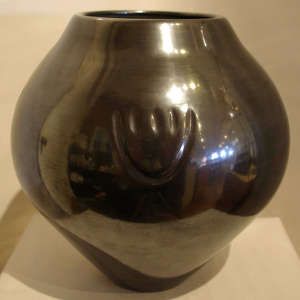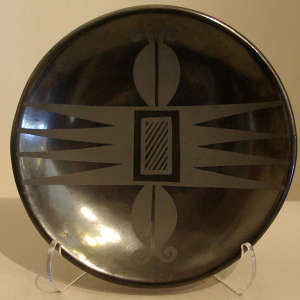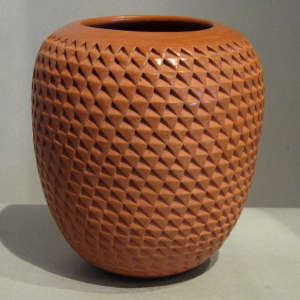Glossary of Terms
Acoma: A New Mexico pueblo that is famous for its white pottery, most of which is painted with fine geometric lines. Sky City at Acoma is one of the oldest continually inhabited "cities" in North America.
Anasazi: Also known as Ancestral Puebloan. The Prehistoric Pueblo Indians of northeastern Arizona, southeastern Utah, southwestern Colorado and northern New Mexico; sometimes referred to as the "Ancient Ones" (Anasazi is a Navajo word meaning Hated ancestors of my enemies), believed to be the common ancestors of most Pueblo tribes.
Anvil & Paddle Method: A technique for making pottery involving the use of a wooden paddle to shape a "pancake" of clay over a pre-existing form, such as a stone or a previously fired pot. After forming the base of the pot, wide strips or thick coils of clay are added to the upper portion, thinned and shaped by continued use of the paddle-and-anvil method.
Avanyu: A popular design (the water serpent) often seen in Native American art of the Southwest, particularly in Santa Clara and San Ildefonso pottery, signifying the prayer for and representation of water, critical for life in the desert. The portrayal of the water serpent also indicates that when it rains in the desert, it often pours. And flash floods are a common result.
Bear Paw: An often used design in pottery and silverwork, especially if the artist is a member of the Bear Clan. More generally the bear paw is a symbol of inner strength. The bear paw is also a hallmark of Santa Clara Pueblo. Legend has it that a bear cub led a child to water and saved the tribe in a time of severe drought.
Black-on-black: A style of pottery developed around 1919 by Maria and Julian Martinez of San Ildefonso Pueblo. It is characterized by two shades of black: one highly polished, the other matte. Designs are made by painting in the negative with the matte black. The process is complicated by the fact that the matte black is an organic paint that is translucent against the polished grey base. Everything turns black in the firing process when manure is poured on the fire to smother it and create an oxygen-reduction atmosphere.
Burnishing: The process of producing a polished, shiny surface by rubbing a smooth stone over the surface of dried pots, plates or bowls
Cochiti: A New Mexico pueblo famous for its figurative clay work, pottery, jewelry and drums
Coil Method: A pottery term used when the potter rolls a long rope of clay and coils it around on top of itself to form the desired shape. In the coil-and-shape method, the walls of the pot are thinned, shaped and smoothed by scraping inside and out with a smooth tool as the potter progresses in forming the vessel
Corn: A powerful symbol in many tribes, used as a design on jewelry, pottery and woven goods to show respect and as a prayer for fertility, prosperity and a good growing season. Also used if the artist is a member of the Corn Clan
Corrugated: A texture on the surface of pottery that resembles corrugated cardboard
Fire cloud: An irregular marking on the exterior of pottery, usually resulting from burning fuel coming in direct contact with the vessel during firing
Firing: For many, the final step in the pottery-making process where the potter literally bakes the piece to harden it. Some sgraffito artists prefer to fire their pieces first and do their artistry after. Modern Pueblo pottery is generally fired for beauty rather than endurance. Water will mar the surface and, if allowed to stand in an unprotected vessel of this type, may actually crumble it. To use as a container for flowers, etc, insert a glass container to hold the water. The only Puebloan pottery that might have a seal good enough to hold water is micaceous. The Navajos usually seal a pot by brushing it with hot pine pitch but most Puebloan pottery has no sealer of any form on it.
Hohokam: An ancient Native American people living in the Sonoran Desert - today's southern Arizona, northern Sonora and northwestern Chihuahua areas, along the Gila and Salt Rivers and their tributaries - during the period from 1-1450 C.E.
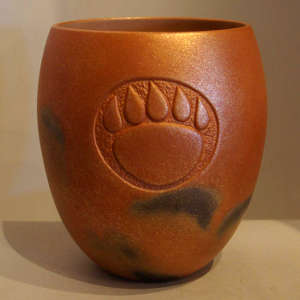
Golden micaceous jar with bear paw
carving and fire clouds
Robert Vigil, Nambe
6 1/4 in H by 5 1/2 in Dia
Hopi: A tribe in northeastern Arizona known for distinctive "overlay" silver jewelry, pottery and Kachina carvings. The Hopi village of Old Oraibi may be the oldest continuously inhabited settlement in North America.
Incising: In pottery, the scratching of lines and designs into the surface of a pot for decorating it. Incising can be done before and after the pot is fired.
Jemez: A New Mexico pueblo in the Jemez Mountains known for its pottery and other arts and crafts like basket-weaving and jewelry-making.
Matte or semi-matte: A dull surface finish, far less glossy than the burnished and polished surfaces of black and/or red ware. Most pottery from Taos, Laguna, Acoma, Zia, Zuni, Nambe, Pojoaque, Tesuque, Jemez, Santo Domingo, Cochiti, San Felipe, Santa Ana, Isleta and Picuris has a matte or semi-matte surface finish.
Micaceous: Containing tiny flakes of mica. The clay of Taos and Picuris is micaceous, giving their pots a sparkling surface. Most pottery coming from Nambe and the Jicarilla Apache these days is also slipped in micaceous clay.
Mimbres Mogollon: An ancient Native American people living in the Mimbres Valley of the Gila Mountains along the southern Arizona and New Mexico border during the period from 300 BCE. to 1200 CE. A subset of the greater Mogollon culture that extended from what is now central New Mexico and eastern Arizona south to northern Chihuahua and southwest to the Copper Canyon area of Sinaloa. Many of the potsherds found in the vicinity of Paquimé (a prehistoric Mogollon city in northern Chihuahua) are decorated in Mimbres styles.

Polychrome jar with floral,
moth and geometric designs
Elizabeth Medina, Zia
10 1/4 in H by 10 in Dia
Mogollon: the name comes from an early Spanish governor of Nuevo Mexico. The Mogollon Rim, a geological formation that runs northwestward from southern New Mexico to west of the Grand Canyon, was named for that governor. The Mogollon people lived along that rim for a couple thousand years. In contradistinction to the Ancestral Puebloans, the Mogollon built square and rectangular kivas out of stone, above ground. There are places in the ancient world where the Mogollon and the Ancestral Puebloans seem to have lived side-by-side but generally, their worldviews seem to have conflicted with each other. The nasty drought in the late 1300s seems to have doomed them as they appear to have melted into the Ancestral Puebloan communities around them by about 1400.
Potsherd: Usually used to describe a fragment of ancient pottery found lying on the ground in the vicinity of an ancient pueblo.
Polychrome: A surface decorated using more than 2 colors.
Pueblo: (village, Spanish) Now an alternate word for reservation or domicile reserved primarily for Native Americans. Used mostly in New Mexico: Pueblos are communities where the people's lives revolve around activities in the central plaza where ceremonial dances are often held. Pueblos are also sovereign nations with their own government, schools, courts and law enforcement agencies.
Salado: An ancient Native American people living in the Tonto Basin along the Salt River and on the rugged slopes of the Superstition and Sierra Ancha Mountains in Arizona during the period from 1150-1450 CE. It is felt that they were a branch of the Hohokam who moved higher in the mountains to the east of the Hohokam homeland. There is also evidence in Salado settlements of groups of Kayenta and Tusayan potters migrating south and then north again in the 1000s, 1100s, 1200s and 1300s. Part of the evidence is in the design vocabularies they left behind and in the Roosevelt Red Ware pottery that some of them made throughout their travels. It is speculated that they made their way northeastward out of the canyons onto the Mogollon Rim and then mostly merged into Zuni society in the 1400s.
Santa Clara: One of the Eight Northern Pueblos in New Mexico, famous for its (often) carved red and black pottery.
Santo Domingo: One of the Eight Northern Pueblos, best known for heishi bead necklaces formed from turquoise and shells; also known for unique, traditional pottery and silversmithing
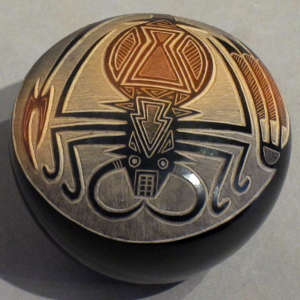
Black seed pot with sgraffito
Mimbres scorpion design
Dean Haungooah, Santa Clara
1 3/4 in H by 2 1/4 in Dia
San Ildefonso: One of the Eight Northern Pueblos, located south of Santa Clara Pueblo along the Rio Grande. Well known for red, black and polychrome pottery, especially the black-on-black technique.
Seed pot: In older times seeds were stored in pottery seed pots: seeds stuffed in through a small hole, then the hole plugged with cloth, clay, corn cob, stick, etc. When it came time to plant again, the seed pot was broken open and the seeds removed. These days the shape of the seed pot is very elastic and the decorations have become much more elaborate as seed pots now usually survive much longer than just a season or two.
Sgraffito: (from the Italian sgraffito) Design formed on a piece of pottery by scratching lines into and removing small parts of the surface of the piece. A process that can happen before and/or after the pottery has been fired.
Slip: A fine, liquid form of clay applied to the surface of a vessel prior to painting and firing. Slip fills in pores and gives uniform color. It usually needs to be applied to the surface several times. Many potters burnish the surface after each coating of slip. Some potters apply multiple layes of multiple colors of slip, then they create a design accented by the colors revealed in the depth and angle of their incisions.
Storyteller: The person acknowledged within the Native American community as the one who verbally passes on historical and cultural beliefs. In almost all tribes, that was a grandfather figure and the stories were sung to children in the native language. Helen Cordero of Cochiti Pueblo was the first to make a clay storyteller surrounded by children. She based the form on her memories of her grandfather singing the old Cochiti stories to the children gathered around him. Within a few years there appeared grandmother storytellers and animal and bird storytellers. There were also storyteller figures holding tens of tiny children... and bundles of gifts, birds and pets, even Santa Clauses with lists of children's names.
Temper: Sand, crushed rock, volcanic soil or ground-up potsherds added to fresh, raw clay to add strength and reduce shrinkage and cracking during drying and firing.
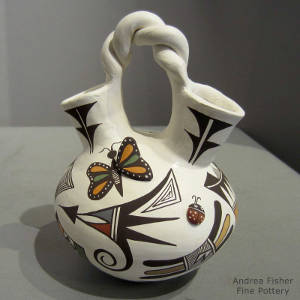
Polychrome wedding vase with
twisted handle and ladybug,
butterfly and geometric designs
Carolyn Concho, Acoma
5 in H by 3 3/4 in Dia
Tewa, Tiwa, Towa, Keres, Hopi, Zuni: The native languages of the Pueblo people. Tiwa is further broken into southern and northern dialects while Keres is broken into eastern and western dialects. In both cases, those of one major dialect are almost unintelligible to those of the other major dialect.
Turquoise: A semi-precious stone used in Native American jewelry, usually found in arid regions. Colors range from blue to greenish yellow, the color mix indicating the particular area the stone is from. It is used in several forms, including: natural - the stone as it is mined; stabilized (chemically hardened); treated (color altered); and reconstituted (turquoise dust chips and plastic resin boutons). In prehistoric times, turquoise was traded far to the south in return for copper bells, seashells and macaws. One example is a trade route followed by one form of turquoise found in the Villa Grove area in the northern San Luis Valley area of Colorado that has been traced as far away as the Mayan temples of Chichen Itza on the Yucatan Peninsula.
Wedding Vase: A traditional, double-spouted vessel used as a ceremonial wedding object.
Zia: A Native American pueblo known for its pottery and its symbols, particularly the Sun symbol which appears on the state flag of New Mexico. Zía is a "living" Eastern Keres pueblo and has been continuously occupied since the 13th century. That said, there are at least 5 major pueblo ruins in the immediate vicinity of today's Zia Pueblo but because Zia is a "living" pueblo, none have been excavated since the controversy over the Zia sun symbol began in the early 1890s. Many Zias also fled into upper Gobernador Canyon during the years after the 1680 Pueblo Revolt. When they were finally convinced to return to Zia in the mid-1690s, they left behind the only whole examples of "Puname" pottery that have ever been found.
Zuni: A Native American pueblo known for fetish carvings, pottery, delicate inlaid jewelry and multiple stone settings, often called "petit point" or "needlepoint". The Zunis have been isolated so long their language is considered an "isolate" and has no common connections with any of the surrounding languages. There are similarities in the Hopi, Zuni and Rio Grande clans and cosmologies but the native languages are mutually unintelligible. The Tewa avanyu is similar to the Zuni kolowisi and similar to the Hopi kwataka in form but the stories and environments behind them are different, adapted to each locale and creation story. There are enough similarities in each story to point to common clan sources, albeit many of those sources are scattered across the countryside with roots going back hundreds, if not thousands, of years.
